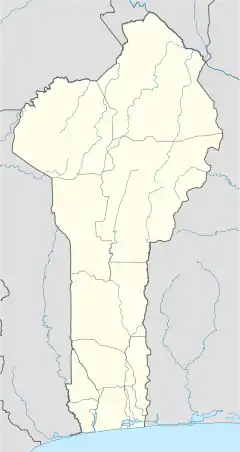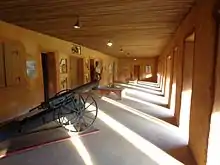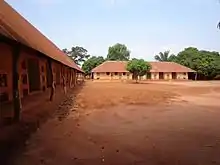Abomey
Abomey is the capital of the Zou Department of Benin. The commune of Abomey covers an area of 142 square kilometres and, as of 2012, had a population of 90,195 people.[1][2]
Abomey | |
|---|---|
.jpg.webp) A street in Abomey in 2017 | |
 Abomey Location in Benin | |
| Coordinates: 7°11′8″N 1°59′17″E | |
| Country | Benin |
| Department | Zou Department |
| Area | |
| • Total | 142 km2 (55 sq mi) |
| Elevation | 221 m (725 ft) |
| Population (2012) | |
| • Total | 90,195 |
| • Density | 640/km2 (1,600/sq mi) |
| Time zone | UTC+1 (WAT) |
Abomey houses the Royal Palaces of Abomey, a collection of small traditional houses that were inhabited by the Kings of Dahomey from 1600 to 1900, and which were designated a World Heritage Site by UNESCO in 1985.[3]
History

Abomey was founded in the 17th century as the capital of the Kingdom of Dahomey (1600–1904), on the site of the former village of Kana.[3] Traditional legends state that the town was founded by Do-Aklin, a son of the king of Allada who ventured north to found his own kingdom; the name is thought to come from Danhomé, also spelled Danxomé, meaning "belly of Dan", Dan being the original chief of the village.[3]
Dahomey expanded rapidly in the 1700s, absorbing many of the surrounding kingdoms, and growing rich from the slave trade.[3] After several attempts, the French conquered the kingdom on 16 November 1892, prompting King Béhanzin to torch the city and flee northward.[3][4] Thereafter the town declined in importance, a process hastened when the French built the new administrative centre of Bohicon immediately to the east.[3] Today, the city is of less importance, but is still popular with tourists and as a centre for crafts.
The Royal Palaces of Abomey


The Royal Palaces of Abomey are a group of earthen structures built by the Fon people between the mid-17th and late 19th Centuries. One of the most famous and historically significant traditional sites in West Africa, the palaces form a UNESCO World Heritage Sites.[3]
The town was surrounded by a mud wall with a circumference estimated at 10 kilometres (6 mi), pierced by six gates, and protected by a ditch five feet deep, filled with a dense growth of prickly acacia, the usual defence of West African strongholds. Within the walls were villages separated by fields, several royal palaces, a market-place and a large square containing the barracks. Only 10 of the original 12 palace survived the 1892 burning by Béhanzin, Dahomey's last king.[3] The French colonial administration rebuilt the town and connected it with the coast by a railroad.
When UNESCO designated the royal palaces of Abomey as a World Heritage Site in 1985 it stated:
- From 1625 to 1900 twelve kings succeeded one another at the head of the powerful Kingdom of Abomey. With the exception of King Akaba, who used a separate enclosure, they each had their palaces built within the same cob-wall area, in keeping with previous palaces as regards the use of space and materials. The royal palaces of Abomey are a unique reminder of this vanished kingdom.
From 1993, 50 of the 56 bas-reliefs that formerly decorated the walls of King Glèlè (now termed the "Salle des Bijoux") have been located and replaced on the rebuilt structure. The bas-reliefs carry an iconographic program expressing the history and power of the Fon people.
Demographics
| Year | Population[7] |
|---|---|
| 1860s | 24 000 |
| 1979 | 38 412 |
| 1992 | 65 725 |
| 2002 | 77 997 |
| 2008 (estimate) | 87 344 |
| 2012 | 90 195 |
Gallery
 "Important witchdoctors" (1908)
"Important witchdoctors" (1908)._-_Dance_of_the_Fon_chiefs.jpg.webp) Dance of the Fon chiefs 1908
Dance of the Fon chiefs 1908 Young girl with wooden statue of mystic chair (1908)
Young girl with wooden statue of mystic chair (1908).jpg.webp) Town Hall, located in the former Governor's Palace
Town Hall, located in the former Governor's Palace One of the royal palaces.
One of the royal palaces.
References
- "Abomey". Atlas Monographique des Communes du Benin. Archived from the original on May 9, 2021. Retrieved January 5, 2010.
- "Communes of Benin". Statoids. Archived from the original on 2 January 2010. Retrieved January 5, 2010.
- Butler, Stuart (2019) Bradt Travel Guide - Benin, pgs. 135-45
- One or more of the preceding sentences incorporates text from a publication now in the public domain: Chisholm, Hugh, ed. (1911). "Abomey". Encyclopædia Britannica. Vol. 1 (11th ed.). Cambridge University Press. p. 67.
- UNESCO World Heritage news, 13 February 2009
- "State of Conservation: Royal Palaces of Abomey (Benin)". UNESCO. Retrieved 27 July 2015.
- "Abomey". World Gazetteer. Archived from the original on December 9, 2012. Retrieved 2008-12-19.

